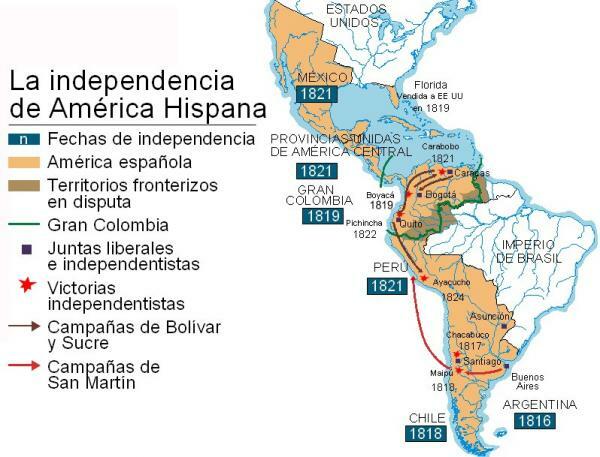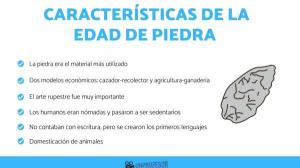Independence of Latin American countries: causes and consequences

Image: Slideshare
The independence process of Spanish continental America is inserted within the framework of the Atlantic revolutions but with structural and conjunctural factors that shape its own history. Specifically, in this lesson from a TEACHER, we are going to focus on causes and consequences of the independence of Latin American countries.
Due to the different constitution and situation of each territory, the process will not be uniform throughout Spanish America, neither in time nor in its internal characteristics. In general, they can be distinguished two processes: a slower and more moderate one that will affect the old viceroyalties (New Spain and Peru); and another more radical one of rupture with the metropolis that will triumph in the Atlantic facade of South America.
Both the cause that initiates it and the decisive impulses of the process depended more on the events and decisions that were made in the metropolis that of an alleged independence spirit or project in the city itself America. In reality, the whole process was linked to the vicissitudes of European politics at the time of the
napoleonic wars and the repercussions of it on the peninsula. The absolute cause of the emergence of the Latin American independence movement is, therefore, the crisis of the Spanish monarchy.The policy of Manuel Godoy, Minister of Carlos IV, shows an inability to face the demands of administrative reform, social and political renewal and economic expansion of his colonies.
Broadly speaking, we could classify the main causes into 3 factors:
- The almost twelve years of war of Spain against England that brought with it the dislocation of the commercial system and consequently the economic crisis of many Latin Americans who held a dominant position within the public administration.
- A second factor was that of fear of land transfers that the European powers could agree among themselves for the realization of peace. One evidence of this is the British invasion of the Río de la Planta in 1806 and 1807 which revealed the inability of the monarchy to depend on its possessions in America.
- The third element would be the abuses of power of the elites over the Creoles framed in absolutism illustrated that leads to reforms in administrative and economic structures that slowed growth economic. Consequently, Creoles developed a nationalist consciousness with the aim of creating a pro-independence government and being able to participate in decision-making.
In the eyes of the elites, the culprit of all this was not another Godoy, who was hated not only for his despotism but above all for having handed over the destiny of the monarchy to France would revolutionize.
In this way, when the dynastic crisis occurred in 1808, the image of the monarchy and its representatives in America had suffered a serious deterioration. Finally, Ferdinand VII as new absolutist successor pushed away any hint of conciliation. Finally, the constitutional period opened in 1820 ended up convincing the American elites that the only solution was independence.

Image: utopia magna casvi-pinosierra
Let's start to analyze the Causes of the independence of the Latin American countries. Here is a list of the most outstanding ones:
The events of the Peninsula of 1808
As we have already said, the direct cause of the beginning of the process was the great crisis that began in March 1808 with the abdications of Bayonne and the appointment of José Bonaparte as the new king of Spain and the Indies. The peninsular reaction against the invader translates into creation of government boards in the provincial capitals proclaiming Fernando as the legitimate king. The Junta of Seville, chaired by Francisco Saavedra, proclaimed itself supreme in Spain and the Indies and did not take long to send emissaries to the colonies for their recognition.
American Reactions: The First and Second Juntista Movement
The reaction of the colonial authorities was translated into a rejection of the dynastic transfer operated in Bayonne and an optimism for the arrival of Fernando VII. Creole elites take advantage of the situation to require the formation of government boards that, as in the peninsula, they assume sovereignty in the absence of the captive king. Finally, the Central Board would be constituted by 27 peninsular against 9 American representatives recognizing for the first time the right of representation of Americans within the government national. This event is known as the first joint movement.
The penetration of liberal principles in America provoked the rupture of these Juntas with the metropolis, being proclaimed as rebellion by the regency. The process is thus radicalized and independence emerges as an inevitable solution for survival. This movement is known as the second joint movement which opens the ban on a follow-up of pro-independence proclamations that would culminate in Bolívar's performance.

Image: Slideshare
The consequences of the independence of the Latin American countries are very complex, We could even say that they continue to creep today. The immediate consequences could be classified as economic, social and political.
Economic consequences
As we have said in the introduction, the process of independence in Latin America is uneven at the territorial and therefore economic level. Still, the common denominator was the economic crisis as a result of a long revolutionary and violent process. The population decline seriously affected production. The opening to foreign trade broke the monopoly for Spain and Portugal and favored the traffic of goods with Great Britain.
Social consequences
The declaration of all citizens without distinction of races and creating a class society They benefited the Creoles, who continued to preserve their wealth. Slavery would disappear progressively according to the territorial situation.
Political consequences
The most significant element was the derivation of the liberal independence movements towards authoritarian forms of government to protect the interests of the elites. Civil wars and territorial conflicts did not cease despite the failed attempt to create a Confederation of Nations by Simón de Bolívar.

Image: Lormaster's blog - Overblog
If you want to read more articles similar to Independence of Latin American countries: causes and consequences, we recommend that you enter our category of Story.



